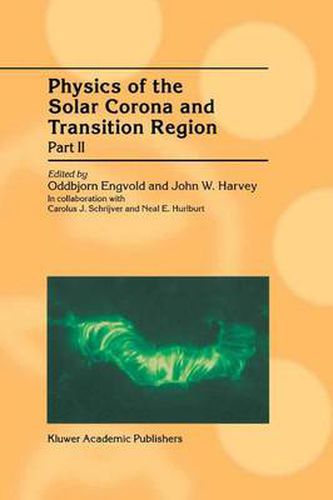Readings Newsletter
Become a Readings Member to make your shopping experience even easier.
Sign in or sign up for free!
You’re not far away from qualifying for FREE standard shipping within Australia
You’ve qualified for FREE standard shipping within Australia
The cart is loading…






This title is printed to order. This book may have been self-published. If so, we cannot guarantee the quality of the content. In the main most books will have gone through the editing process however some may not. We therefore suggest that you be aware of this before ordering this book. If in doubt check either the author or publisher’s details as we are unable to accept any returns unless they are faulty. Please contact us if you have any questions.
Solar Physics publishes up to two TopicalIssues per year that focus on areas of especially vigorousand activeresearch. The present TopicalIssue containspapers of recent results on the solar corona, as well as on the transition region and low solar wind. The majority of these papers, which were all refereed in accordance withthe standards of Solar Physics, werepresentedin August 1999at a workshop heldin Monterey, California. TheSun’s magneticfieldis responsibleforthe spectacularly dynamicand intri- cate phenomenonthat we call the corona. The past decade has seen an enormous increase in our understanding of this part of the solar outer atmosphere, both as a result of observations and because of rapid advances in numerical studies.The Yohkoh satellitehasobservedthe Sun nowfor overeightyears, producingspectac- ular sequences of images that conveythe complexity of the corona. The imaging andspectroscopic instrumentsonSOHOhaveaddedinformationonthecoolerpart of the corona. Andsince April of 1998TRACEhas givenus very high resolution imagesof the 1-2 MKcorona, atcadencesthat allowdetailedobservations of field oscillations, loopevolution, mass ejecta, etc. The papers of thisTopicalIssue revolvearoundone keytheme:the entire outer atmosphereof the Sun is intrinsicallydynamic, evolvingso rapidly that even the concept of a single local temperaturefor a single fluid often breaks down. More- over, the corona is an intrinsicallynonlinearand non-localmedium.These aspects are discussedin thisTopicalIssue, includingboth papers that reviewrecentdevel- opments(both basedon observations and on theoretical/numerical modeling), and original research papers based on observations from many different observatories. Weareverygratefulto the manyrefereeswhoweregivenlittletimeto respond, andto the staffofKluwerfor theproductionofthetopicalissuesandtheirreprints. Thepapers acceptedforthisTopicalIssueadduptosuchavolumethattheyhaveto be distributedovertwo TopicalIssues of SolarPhysics (December 1999and April 2000),which are reprintedin two bound volumes, of whichthis is the second.
$9.00 standard shipping within Australia
FREE standard shipping within Australia for orders over $100.00
Express & International shipping calculated at checkout
This title is printed to order. This book may have been self-published. If so, we cannot guarantee the quality of the content. In the main most books will have gone through the editing process however some may not. We therefore suggest that you be aware of this before ordering this book. If in doubt check either the author or publisher’s details as we are unable to accept any returns unless they are faulty. Please contact us if you have any questions.
Solar Physics publishes up to two TopicalIssues per year that focus on areas of especially vigorousand activeresearch. The present TopicalIssue containspapers of recent results on the solar corona, as well as on the transition region and low solar wind. The majority of these papers, which were all refereed in accordance withthe standards of Solar Physics, werepresentedin August 1999at a workshop heldin Monterey, California. TheSun’s magneticfieldis responsibleforthe spectacularly dynamicand intri- cate phenomenonthat we call the corona. The past decade has seen an enormous increase in our understanding of this part of the solar outer atmosphere, both as a result of observations and because of rapid advances in numerical studies.The Yohkoh satellitehasobservedthe Sun nowfor overeightyears, producingspectac- ular sequences of images that conveythe complexity of the corona. The imaging andspectroscopic instrumentsonSOHOhaveaddedinformationonthecoolerpart of the corona. Andsince April of 1998TRACEhas givenus very high resolution imagesof the 1-2 MKcorona, atcadencesthat allowdetailedobservations of field oscillations, loopevolution, mass ejecta, etc. The papers of thisTopicalIssue revolvearoundone keytheme:the entire outer atmosphereof the Sun is intrinsicallydynamic, evolvingso rapidly that even the concept of a single local temperaturefor a single fluid often breaks down. More- over, the corona is an intrinsicallynonlinearand non-localmedium.These aspects are discussedin thisTopicalIssue, includingboth papers that reviewrecentdevel- opments(both basedon observations and on theoretical/numerical modeling), and original research papers based on observations from many different observatories. Weareverygratefulto the manyrefereeswhoweregivenlittletimeto respond, andto the staffofKluwerfor theproductionofthetopicalissuesandtheirreprints. Thepapers acceptedforthisTopicalIssueadduptosuchavolumethattheyhaveto be distributedovertwo TopicalIssues of SolarPhysics (December 1999and April 2000),which are reprintedin two bound volumes, of whichthis is the second.